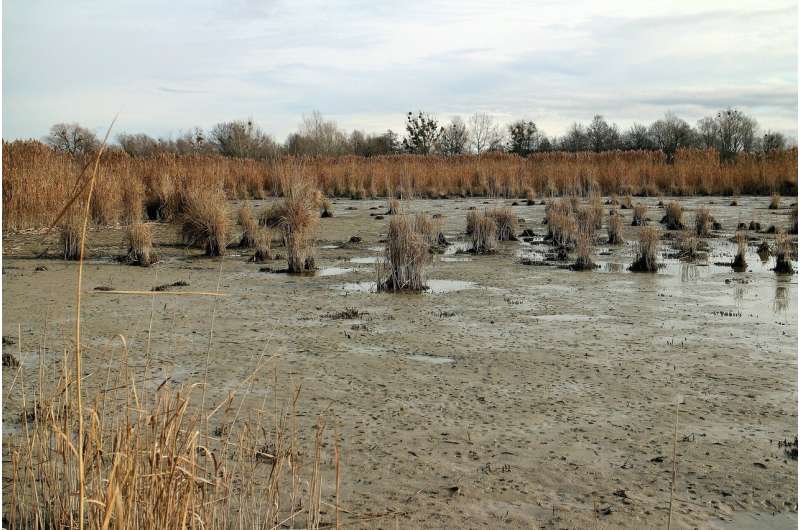New Jersey’s tidal marshes in danger of disappearing, study shows

New Jersey’s tidal marshes aren’t keeping up with sea level rise and may disappear completely by the next century, according to a study led by Rutgers researchers.
The findings, which include potential solutions for preserving the marshlands, appear in the journal Anthropocene Coasts. The research team’s study follows its 2020 report on the same issue for the Science Advisory Board of New Jersey’s State Department of Environmental Protection (NJDEP.)
“Faced with sea level rise, a marsh has two options—it can either increase its elevation at a rate equal to that of sea level rise or it can migrate inland,” said lead author Judith Weis, a professor emerita of biological sciences at Rutgers-Newark. “Otherwise, it will be submerged and drown.”
Tidal marshes –where the oceans meet the land and become vulnerable to sea level rise—are vital habitats for many aquatic organisms, such as fishes, crabs and shrimp, as well as birds and mammals and provide a buffer against storm surges, winds and flooding. They also absorb pollutants such as toxic metal; nitrogen, which reduces algal blooms and carbon dioxide and contributes to climate change.
The research team reviewed previous studies of coastal marsh systems in New Jersey, focusing on the Meadowlands, Raritan Bay, Barnegat Bay and Delaware Bay. For each marsh system, they examined horizontal changes—changes in marsh area over time—and vertical changes in elevation.
For the Meadowlands, the researchers couldn’t determine losses to sea level because due to the extent of human development on the marshes. For the Raritan Bay, they found no published data and little evidence that marsh area is being lost.
But they found that Barnegat Bay has lost a large amount of area to erosion, and Delaware Bay has similarly had considerable erosion from the edges, although those losses have been compensated for by inland migration of the marshes into coastal areas. The march migration, however, is causing “ghost forests,” where many trees have died due to sea water intrusion. Such migration isn’t possible in more developed parts of the state, where roads and buildings immediately inland of the marshes act as barriers.
The researchers found that most marshes throughout the state are not increasing their elevation as rapidly as the sea level is rising, which was 5-6 mm/year as of 2019 when the last data were collected. The rate of sea level rise in the mid-Atlantic is higher than the worldwide average for various geophysical reasons.
The only marshes elevating substantially faster than the rate of sea level rise were two marshes in the Meadowlands dominated by the common reed Phragmites australis, an invasive plant that reduces plant diversity in tidal marshes.
The team looked at four strategies to mitigate the loss of New Jersey’s marshes. First, they would encourage municipalities to buy and demolish houses that prevent marshes from migrating inland. Such a “managed retreat” program would be expensive and likely face political and social opposition.
Under the second strategy, marshland managers would remove fewer invasive reeds, which are currently killed using toxic herbicides and replaced with native cordgrass when funding is available. Although the reeds slightly reduce biodiversity, they have some benefits, such as absorbing pollutants, nitrogen and carbon dioxide more effectively than native marsh grasses. The reeds, which are denser and taller than native grasses, also are a better buffer against flooding and enable marshes to elevate faster. When they die, they create more dead plant material that doesn’t decay as rapidly as other marsh plants, which traps more sediments that enable the marsh to elevate more rapidly.
“Some reeds should be left on the marsh surface to give the marsh a better chance of keeping up with sea level rise,” said Weis. “This will be controversial and likely opposed by many marsh managers, which will require a revolutionary change in marsh management.”
The third strategy would involve adding new sediments on top of marshes that are not elevating as fast as they need to. One such method called “thin layer deposition” involves spraying sediment from creeks up onto the marsh surface. This experimental method is being tried at sites in South Jersey and shows promising results. A symptom of a marsh “in trouble” is retaining water on the marsh surface at low tide. This “ponding” can kill grasses adapted to being under water only periodically. Digging narrow channels, called “runnels,” from ponded areas to nearby tidal creeks can help drain the water.
The fourth strategy, called “living shorelines,” would involve experimental techniques to slow erosion at the edge of a marsh. Harder materials, preferably oyster or mussel reefs but sometimes concrete blocks, can be placed in front of the marsh edge to shield waves that erode the marsh edge. These techniques are being tested in several locations in the Delaware Bay and are yielding valuable information on suitable locations and materials.
Half of U.S. tidal marsh areas vulnerable to rising seas
Judith Weis et al, The status and future of tidal marshes in New Jersey faced with sea level rise, Anthropocene Coasts, 2021. DOI: 10.1139/anc-2020-0020
Citation:
New Jersey’s tidal marshes in danger of disappearing, study shows (2021, October 6)
retrieved 6 October 2021
from https://phys.org/news/2021-10-jersey-tidal-marshes-danger.html
This document is subject to copyright. Apart from any fair dealing for the purpose of private study or research, no
part may be reproduced without the written permission. The content is provided for information purposes only.
For all the latest Science News Click Here
For the latest news and updates, follow us on Google News.

